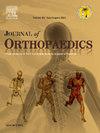类似的运动模式后稳定和髁约束膝关节假体在翻修膝关节置换术:一项前瞻性队列研究
IF 1.5
Q3 ORTHOPEDICS
引用次数: 0
摘要
背景:原发性全膝关节置换术(pTKA)发病率的上升预计将导致更多的翻修性全膝关节置换术(rTKA),这将带来更大的挑战和更差的结果,给患者和医疗保健系统带来负担。膝关节运动学在pTKA预后中起关键作用,但对rTKA知之甚少,其中高约束植入物和关节线抬高(JLE)可能影响膝关节运动学。该研究的目的是:(1)比较后稳定(PS)和髁约束(CCK)假体在rTKA开链和闭链训练中的运动学模式;(2)评估JLE对前后翻译和凸轮后接合的影响。方法对30例于2022年至2024年间接受rTKA的患者(19例使用PS种植体,11例使用CCK种植体)进行至少6个月的随访。在开链屈伸(FE)和闭链运动(坐立(STS)和蹲(SQ))期间,使用透视分析胫骨股骨运动学。(1)比较了PS和CCK植入体的运动学模式,重点关注AP平移、内外旋(IE)旋转、内翻外翻(VV)旋转、运动范围(ROM)和凸轮后啮合。(2)在负重x线片上,关节线升高定义为与正常膝关节相比升高≥4mm,并对有jle和没有jle的患者进行比较。结果(1)在rTKA中,PS和CCK植入物的运动学模式没有显著差异。(2) JLE≥4 mm导致下蹲时不稳定,特别是在屈曲早期和中屈曲时,内侧腔室明显更前位(0-30°:p = 0.037;30-60°:p = 0.021)。结论:(1)CCK植入物与PS植入物在修复设置中具有相似的运动学模式,支持在适当的时候使用;(2)JLE与早期和中期屈曲下蹲时的不稳定有关。本文章由计算机程序翻译,如有差异,请以英文原文为准。
Similar kinematic patterns in posterior-stabilized and condylar constrained knee prostheses in revision knee arthroplasty: a prospective cohort study
Background
The rising incidence of primary total knee arthroplasty (pTKA) is expected to lead to more revision TKAs (rTKA), which pose greater challenges and poorer outcomes, burdening both patients and healthcare systems. Knee kinematics play a key role in pTKA outcomes, but less is known about rTKA, where high-constraint implants and joint line elevation (JLE) may affect knee kinematics. The study aimed to: (1) Compare kinematic patterns between posterior-stabilized (PS) and condylar constrained (CCK) implants during open- and closed-chain exercises in rTKA; (2) Assess the impact of JLE on anteroposterior translation and post-cam engagement.
Methods
Thirty patients (19 with PS implants and 11 with CCK implants) who underwent rTKA between 2022 and 2024 were tested at a minimum six-month follow-up. Tibiofemoral kinematics during open-chain flexion-extension (FE) and closed-chain exercises (sit-to-stand (STS) and squatting (SQ)) were analyzed using fluoroscopy. (1) Kinematic patterns were compared between PS and CCK implants, focusing on AP translation, internal-external (IE) rotation, varus-valgus (VV) rotation, range of motion (ROM) and post-cam engagement. (2) Joint line elevation was defined as a ≥4 mm increase compared to the native knee on a weight-bearing radiograph, and comparisons were made between patients with and without JLE.
Results
(1) No significant differences were observed in kinematic patterns between PS and CCK implants in rTKA. (2) A JLE ≥4 mm led to instability during squatting, particularly in early- and mid-flexion, with a significantly more anterior position in the medial compartment (0–30°: p = 0.037; 30–60°: p = 0.021). Although post-cam engagement was delayed in patients with JLE, the difference was not statistically significant (p = 0.173)
Conclusion
(1) CCK implants have a kinematic pattern similar to PS implants in revision setting, supporting their use when appropriate, (2) JLE is associated with instability during squatting in early- and mid-flexion.
求助全文
通过发布文献求助,成功后即可免费获取论文全文。
去求助
来源期刊

Journal of orthopaedics
ORTHOPEDICS-
CiteScore
3.50
自引率
6.70%
发文量
202
审稿时长
56 days
期刊介绍:
Journal of Orthopaedics aims to be a leading journal in orthopaedics and contribute towards the improvement of quality of orthopedic health care. The journal publishes original research work and review articles related to different aspects of orthopaedics including Arthroplasty, Arthroscopy, Sports Medicine, Trauma, Spine and Spinal deformities, Pediatric orthopaedics, limb reconstruction procedures, hand surgery, and orthopaedic oncology. It also publishes articles on continuing education, health-related information, case reports and letters to the editor. It is requested to note that the journal has an international readership and all submissions should be aimed at specifying something about the setting in which the work was conducted. Authors must also provide any specific reasons for the research and also provide an elaborate description of the results.
 求助内容:
求助内容: 应助结果提醒方式:
应助结果提醒方式:


